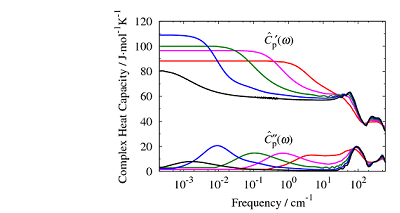| Dynamical origin of thermodynamic properties: Analysis based on complex specific heat and complex entropy |
We have investigated molecular origin of anomalous prperties of water by developing the quantum-corrected complex specific heat and entropy.
Thermodynamic picture of vitrification of water through complex specific heat and entropy: A Journey through ‘No Man’s Land’
We investigate thermodynamic properties of supercooled water across the “no man’s land” onto the formation of amorphous ice. The calculations are aided by very long computer simulations, often more than 50 μs long, with the TIP4P/2005 model potential. Density fluctuations that arise from the proximity to a putative liquid-liquid (LL) transition at 228 K, cast a long shadow on the properties of water, both above and below the LL transition. We carry out the calculations of the quantum mechanical static and frequency-dependent specific heats by combining seminal works by Lebowitz, Percus, and Verlet and Grest and Nagel with the harmonic approximation for the density of states. The obtained values are in quantitative agreement with all available experimental and numerical results of specific heats for both supercooled water and ice. We calculate the entropy at all the state points by integrating the specific heat. We find that the quantum corrected-contributions of intermolecular vibrational entropy dominate the excess entropy of amorphous phases over the crystal over a wide range of temperature. Interestingly, the vibrational entropy lowers the Kauzmann temperature, TK, to 130 K, just below the experimental glass-to-liquid water transition temperature, Tg, of 136 K and the calculated Tg of 135 K in our previous study. A straightforward extrapolation of high temperature entropy from 250 K to below however would give a much higher value of TK~190 K. The calculation of Lindemann ratios places the melting of amorphous ice ~135 K. The amorphous state exhibits an extremely short correlation length for the distance dependence of orientational correlation.
Saito and Bagchi, J.Chem.Phys., (2019).
Frequency dependence of specific heat in supercooled liquid water and emergence of correlated dynamics
Molecular origin of the well-known specific heat anomaly in supercooled liquid water is investigated here by using extensive computer simulations and theoretical analyses. A rather sharp increase in the values of isobaric specific heat with lowering temperature and the weak temperature dependence of isochoric specific heat in the same range are reproduced in simulations. We calculated the spatio-temporal correlation among temperature fluctuations and examined the frequency dependent specific heat. The latter shows a rapid growth in the low frequency regime as temperature is cooled below 270 K. In order to understand the microscopic basis of this increase, we have performed a shell-wise decomposition of contributions of distant molecules to the temperature fluctuations in a central molecule. This decomposition reveals the emergence, at low temperatures, of temporally slow, spatially long ranged large temperature fluctuations. The temperature fluctuation time correlation function (TFCF) can be fitted to a William-Watts stretched exponential form with the stretching parameter close to 0.6 at low temperatures, indicating highly non-exponential relaxation. Temperature dependence of the relaxation time of the correlation function can be fitted to Vogel-Fulcher-Tamermann (VFT) expression which provides a quantitative measure of the fragility of the liquid. Interestingly, we find that the rapid growth in the relaxation time of TFCF with lowering temperature undergoes a sharp crossover from a markedly fragile state to a weakly fragile state around 220 K.
Saito, Ohmine, Bagchi, J.Chem.Phys., 138, 094503 (2013).


